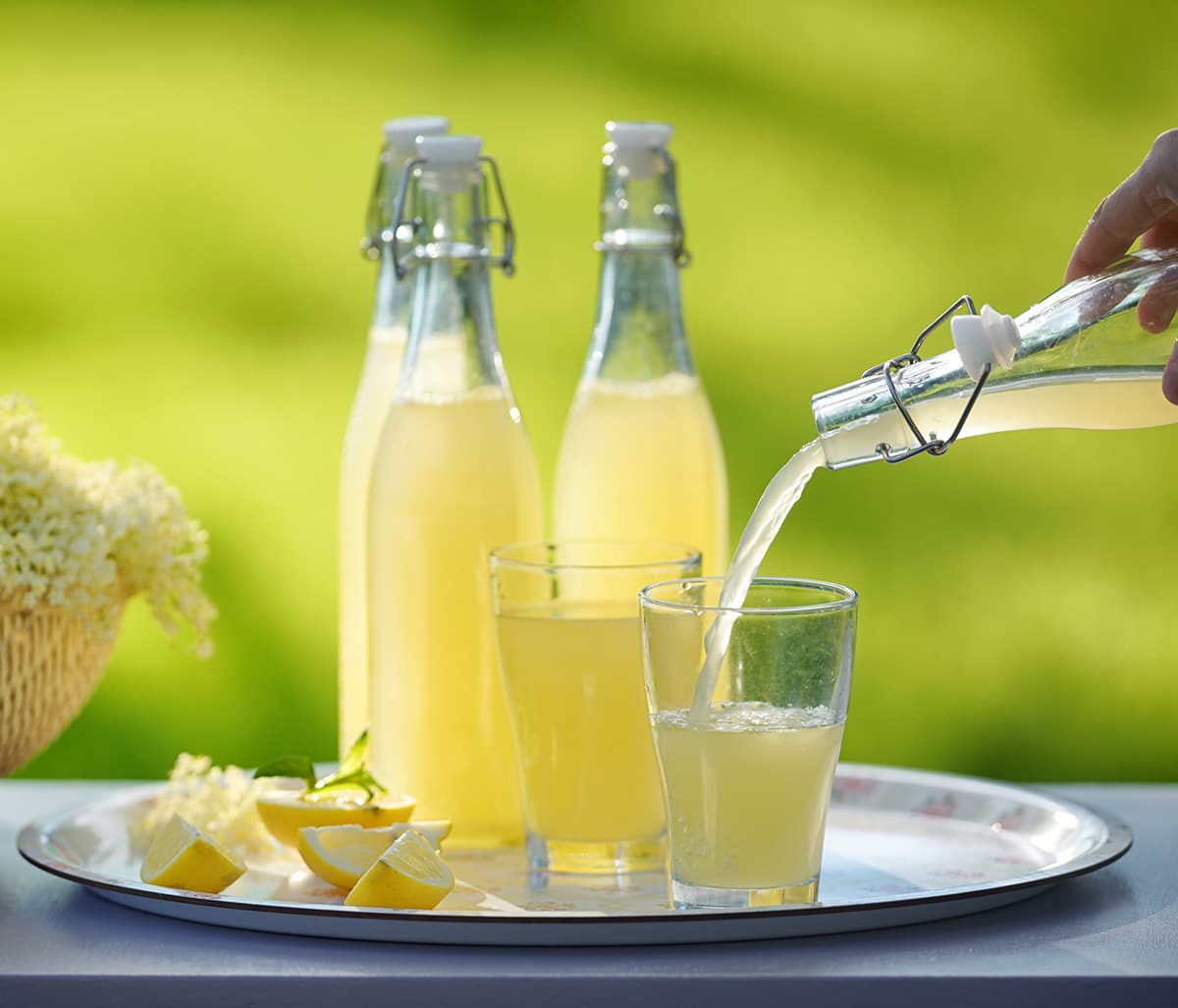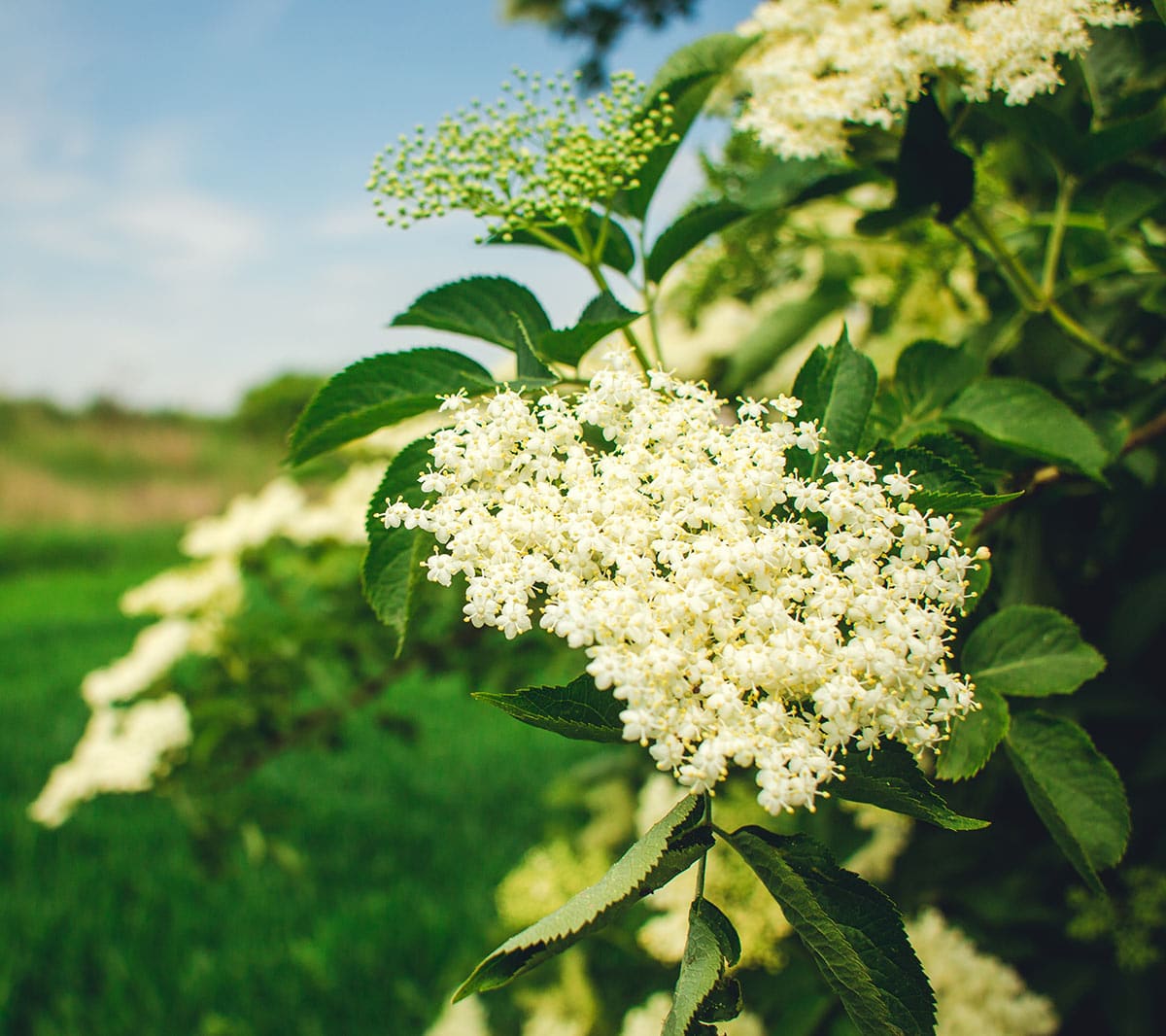As an Amazon Associate I earn from qualifying purchases.
Elderflower cordial is sunlight and rainbows in a bottle. Golden, floral and sweet, this syrup makes everything it touches better. Here’s how to make it at home.

April is a wonderful month. Flowers are everywhere, fishing is getting into gear and the summer garden is laden with promise. Foraging can be a little thin in my neck of the woods, however, as the greens are starting to go as the weather warms. But there is one delight to be had: Elderflowers to make elderflower cordial.
Finding the buttercream flowers isn’t too tough: Elderberries grow everywhere near rivers, and Northern California is loaded with bushes big and small. I’ve never seen them before April here, but they bloom even earlier in SoCal, and in the Southeast.
I’ve seen elderflowers all over the place in Georgia and Florida in early spring. The farther north you live — or the higher in elevation — the later you must wait. And keep in mind you are looking for blue or black elderberries, not red elderberries. You want Sambucus nigra or S. mexicana.

Collecting Elderflowers
Keep in mind that an elderberry bush is a large plant, and can even grow into a small tree. Study the leaves in the photo above: They are a lush dark green, slightly serrated on their edges, and form on stalks; each leaf should be opposite to another. The flowers are cream-colored, not white.
Sometimes over-eager foragers fail to look at the plant they are picking from and grab hemlock by mistake. This can be fatal. But hemlock looks nothing like elderberry, so I have a tough time figuring out how this mistake happens…
A good rule to live by is to not take more than a few flower heads from each elderberry bush: This ensures that the bush will have enough to spread itself, it makes you find more bushes — it’s never a good thing to have only one spot for anything you forage for — and, most importantly, selective picking means you can come back in a few months for the berries.
Only choose the most beautiful flower heads; you don’t want flowers that have yet to open or are past their prime. Collect them in a paper bag so they can breathe. Plastic will make them wilt and sweat.
You will need a lot of flowers to make cordial, so grab a big grocery sack full.
Making Elderflower Cordial
Keep in mind that elderflower cordial is not alcoholic. It is anything from a light, ready to drink concoction to a syrup that can keep a year or more and is used as a base for other things, like elderflower champagne.
If you want to make elderflower liqueur, this is my recipe for that.
Elderflower cordial has a subtle flavor. What does it taste like? It is more of an aroma thing, although the elderflower “lemonade” I am drinking right now has a certain tannic backbone to it that says it is not just lemonade.
You make the base for elderflower cordial by preparing a simple syrup (1:1 sugar to water), bringing it to a boil and pouring it over lemon zest, a little lemon juice, lots of elderflowers, and a little citric acid, which adds flavor and keeps everything stable. You let this sit at room temperature for 2 or 3 days to macerate, and the result after you strain it through cheesecloth is this lovely-looking syrup.
NOTE: If you just want to make an elderflower simple syrup, which will ferment very fast if you don’t keep it really cold, skip all the lemon and citric acid. For a quart, boil 3 cups sugar and 3 cups water. Let it cool enough so you can stick your finger in it, then pour it over a quart Mason jar full of elderflowers. Steep 24 to 48 hours, then strain. Use within 3 weeks.
Using Elderflower Cordial
I add about a tablespoon of the syrup to a pint of water to make an elderflower cordial with the level of flavor Gatorade has; add more syrup for a stronger drink. It tastes a lot like an Arnold Palmer (50-50 iced sweet tea and lemonade), but as elderflowers are known to be seriously good for you, I like this better.

Holly added some syrup to vodka to make an “Elder-tini,” which, when added to some cherries, make a damn good cocktail. Elderflower cordial is also excellent mixed with Champagne (a classic), and its Italian cousin Prosecco. My friend Heather makes a drink called a Caddisfly Nymph, which is elderflower syrup, Prosecco and a touch of Peychaud bitters.
Elderflower cordial makes a great glaze for chicken or pheasant breasts, or, when mixed with a champagne vinegar, a helluva gastrique (sweet and sour sauce) for poultry, rabbit or fish.
Elderflower Cordial
Ingredients
- 1 quart water
- 4 cups sugar
- Juice of 2 lemons
- Zest of 2 lemons
- 1 teaspoon citric acid
- 25 elderflower heads, about 2 cups flowers, stems removed
Instructions
- Snip off the flowers from the stalks into a large bowl or bucket that will hold everything. Try to remove as much of the stems as you can; they are toxic. A few stray bits of stems will not hurt you, but you want to minimize it.
- Zest the lemons and add it to the bowl, then the citric acid and lemon juice.
- Bring the sugar and water to a boil, stirring occasionally to dissolve. Let the syrup cool enough so that you can stick your finger in it without getting burned; you can leave it to cool to room temperature, too. Pour the syrup over the flowers, lemons et al and stir to combine. Cover the bowl or bucket with a towel and leave it for 2 or 3 days.
- When you are ready, strain it through a fine-meshed sieve lined with cheesecloth or a paper towel into a clean Mason jar. Seal the jar and store in the fridge.
- To serve, pour 1 to 3 tablespoons of the syrup into a pint glass and add water or seltzer. Or you can add a tablespoon to a glass of sparkling wine, or to a couple shots of vodka or gin.
Notes
Nutrition
Nutrition information is automatically calculated, so should only be used as an approximation.






Could you use dried?
Rather than tossing out the wrung out flowers and zest leftover from making this, I’m making a batch of cookies with them. My process: cream a stick of butter, the flowers, a little brown sugar and a small pinch of salt. Then I added an egg, then pastry flour til it felt like cookie dough. I patted them out flat and baked at 375° until they smelled up the house and looked golden. The result: nice flavor, chewy texture. Not the best cookies ever, but definitely worth making! Recipe could be refined to balance the ratio of ingredients. Mixing the dough in a food processor may improve the texture.
Hi,
I felt in love with elderflower when I tasted in Europe. Where can I find the flower in San Francisco so I can try your amazing receipt? Should I go into woods or somewhere close to river?
Serene: I see them in Marin County a lot, inland. There is a red elderberry on the shore that is not very good.
We also live in the Bay Area and find elder trees all over the place. We live on the Peninsula near to the coast, but we’ve seen them in the East Bay and down in the Valley as well. We are past elderflower season now, but there are blue elderberries to be found now!
Hi. I’ve been making elderberry jelly for 40 years and harder than find berries now because the birds eat them even when green. Oh well they need them more than me. I am interested in trying some of the elderflower treats. Have heard of elderflower pancakes as well. Yes always cut off any excess stem leaves, etc because the plants contain hydrocyanic acid evidently less in the fruit and flowers. Delicious
I live in Utah and have never heard of Elderflower. I do have a drink that can be made and it calls for Elderflower, do you know how I can get Elderflower here in Utah?
Margaret: It grows in every county in Utah. Look up Sambucus nigra, ssp. cerulea. You can’t really buy it, though, you need to find your own.
Hi Hank,
I have excitedly found what my husband and I believe to be S. Cerulea. My aunt made us a batch from her European elder bush last year so I was excited to try it from the wild growing variety I found in Washington. I picked the flowers this past weekend, tried for the first time making this cordial and ended up throwing it out (twice) because after the flowers were submerged in water the smell was so off- putting I couldn’t imagine adding it to anything to enjoy the taste. It seemed strange to me that the syrup I made changed the scent of the flowers from sweet and pollen to green, leafy. What does your finished product smell like?
Here’s a tip. Dry the flowers in the dehydrator and then steep them in simple syrup. Doesn’t seem to ferment on me, but I keep in the frig. I use it like you do. But I’ll try this recipe. Elder flowers coming on strong now here in central Washington state.
I was glad to find you recipe again this year. I was in a rush 2 days ago since my elderberry tree was loaded with blooms and I knew it was peak time to pick them and made a different recipe, called for 4 cups of elderflowers, and zest and juice of 1 lime, and no citric acid. Other than that it was the same process and recipe as yours I’m disappointed that it tastes fermented, yikes after all that hand picking of those teensy flowers! I can already tell that your recipe is better and I’ve only just poured the sugary syrup over it. Thank you! If you have any suggestion for fixing other batch I’d appreciate it, it’s not terrible just a little off.
Could you use dried elder flowers?
Michelle: Yes, people do. I never have, however.
Please can one freeze the elder blossoms?
Gudrun: Not sure. I have never tried.
Just made my first batch of syrup with flowers harvested from about 8,000′ elevation in Lamoille Canyon, Nevada. First drink was a much improved version of Starbucks’ Passion Tea-Lemonade. Next, we’ll try it with gin or prosecco. I’ll be ready to harvest a bunch more next year, flowers are pretty well gone at lower elevations and not many bushes at the higher parts of the canyon.
I love this recipe. I planted 2 elderberry bushes and this is their third year I had gorgeous dinner plate sized blooms.. using no fertilizer. Thank you for stating 2 cups of blossoms, the other recipes I used called for 25-30 flowers and it looked like too many for me. I used 7 flowers for 2 cups. So I was able to make 2 batches, considering a third which will still leave elderberries for later. I want to keep mine more than 3 weeks, can I freeze it? Maybe make large ice cubes and seal or could I freeze in mason jars? I scoured all my grocery stores for citric acid, even the spice and produce experts in the stores looked at me like I was talking about some crazy non-existent dangerous ingredient. Just as I was about to head 45 minutes away to a health food store, I found something recommended by a chef in the deli department called Fruit-Fresh, produce protector, it has citric acid and ascorbic acid, dextrose, and silicon dioxide. It worked just fine, but since I love to try to be a s natural as possible, I’m ordering some organic critic acid online so I have it when the small window of making elderflower cordial arises next time. Thanks for the recipe and the explanation. DELICIOUS and also terrific with limes.
You can find citric acid in the “canning” area of stores. There isn’t “organic” citric acid as it’s just a molecule.
The citric acid molecule is not synthesized, but rather harvested from a liquid fermentation product of an Aspergillus mold in industrial bioreactors.
I have ‘Black Beauty’ elderberry. ‘Gerda’. Can that be used to make the syrup?
Great simple recipe – I have to agree that picking early in the day gives you the best end result. We only had meyer lemons from our bush and I actually prefer that flavor vs. the organic lemon used in 2nd batch. Dig the blood orange derivation as well.
Tanks Hank !
I’m looking forward to reading your articles about elderberries. I’ve wanted to make wine or jelly with them for several years and am finally doing it this year. The berries here in south Louisiana don’t have the dusted appearance or at least I’ve never seen them that way. At what I think is the ripe stage, they’re dark purple and very easily squished. Should I be concerned because they don’t have that whitish coating?
In the Toronto, Canada area I am lucky to have bought a house with an elderberry bush. We used the berries for years for jam and to feed the birds. It has the tiny flowers on very large bundles, smells lovely in the morning, and they ripen into dark black berries. A few years ago my daughter gave me the idea of cordial (or pressé). I snip the blooms off the tree by clasping the flower head as close to the flowers as possible to save the step of further trimming. I make batches every year and have frozen it as well. Love it mixed with bubbly water (I use my Soda Stream). Not bad with a splash of gin for a summer cocktail. Just about to try making liquer for the first time. (Fill a quart jar loosely with blossoms and cover them with 70 proof vodka or 100 proof liquor. Tightly lid and put in cool, dark place for a few weeks. It will darken. Strain twice, second time through sieve lined with cheese cloth. Add sugar to taste, replace lid. Shake every couple of days to fully dissolve the sugar.)
To Jason’s earlier comment: We really only have one edible wild elder in the northeastern US/ eastern Canada, the Common Elderberry (Sambucus canadensis). The tiny, creamy-white flowers blossom in a flat, like two-dimensional grouping called a cyme. They ripen into dark purple, almost black, berries which, when ripe and heavy, will bend their branch over quite a bit.
If the flower cluster is shaped more like a lilac or hyacinth, then I would be wary. That would likely be the toxic Red Elder (S. _____. Botanists have recently decided that S. canadensis and the European Black Elderberry (S. nigra). That might be your source of confusion.
I’ve used this recipe for a couple of years now and love it.
I’ve now moved to a different part of Denmark so I hope the final drink is just as good. This year is really good for elderflowers.
I think the variety of elder trees we have in the United States is slightly different than the ones in Europe and Asia. I am in Los Angeles, California and the flowers are so pretty but never any fragrance that would make my heart sing.
My elderberries are also really small.
Fatemeh: Really?! I think you are trying to harvest them at the wrong time of day. My friends who forage in LA County love their elderberries, as do I 400 miles north of you in Sacramento. Try harvesting early in the day. You’ll get the aroma. That said, yes, it is different from the European varieties.
I think this is great stuff. I substitute 2 blood oranges for one of the lemons. It’s what I have on hand and it gives a nice ‘blush’ to the syrup.
Even in the small area I am familiar with, ( all blue elder) the flowers vary in odor. The fragrance is best early in the day, but even then an occasional tree has flowers that remind me of cat box!
Ron: Good idea on the blood oranges! And you are absolutely correct. The aroma is best before noon, and can be very variable.
I have tried to make this cordial for a couple of years now and either I have a different variety here in the Northeast or I’m just missing something. I collect the berries from the same plants so I know I’m using elderflowers. The flowers are just OK at best. Even then I’m probably more infatuated with the idea than I am with the end result. Any thoughts on different strains of elderflowers in NE US?
Our native elderflower smells unpleasant to me, but I love the syrup. I wonder why?
Thanks for the interesting recipe.